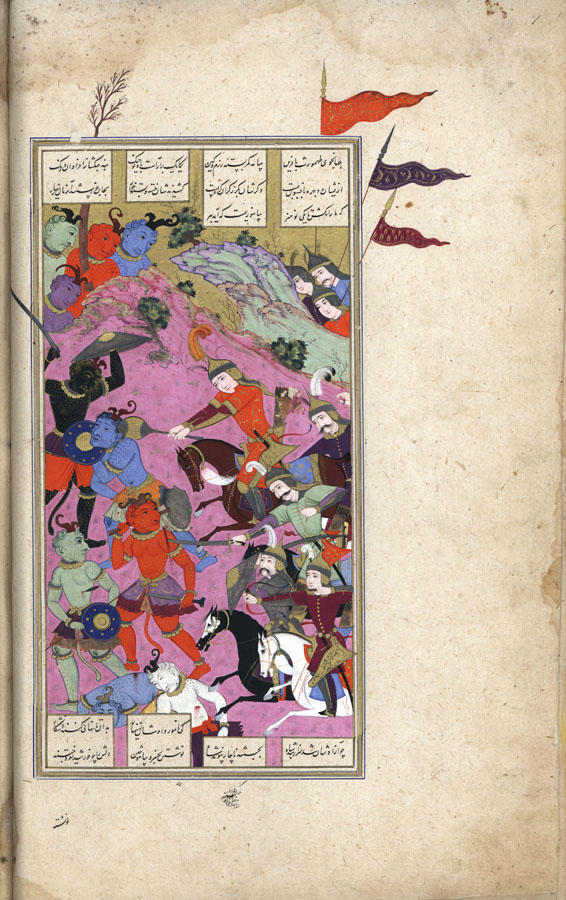Ṭahmuras̱ and the Divs
The composition can be divided vertically down the center: on the right are Ṭahmuras̱ and his forces; on the left the divs who “flee” before his onslaught. This right-left direction of motion is typical of battle scenes and might be the logical consequence of a script that flows in the same direction. Ṭahmuras̱ is the dominant figure among the attackers, appearing near the center astride a chestnut charger. He wears a pointed steel helmet, an encased bow with quivers on his belt, and lunges forward to crash a bulbous mace down on a div who buckles under the force of the blow. In the lower right, four other warriors, similarly dressed and tightly grouped together, represent Ṭahmuras̱’ army. Mounted, they pursue the divs with swords flying and bows drawn. The heads of three standard bearers can be seen observing the battle from behind the ridge in the upper right, their standards protruding into the margins. Despite differences of body color, pose, and minor variation, the divs are all similarly represented, with large heads, human bodies, and tails. Their facial features are human, but an attempt has been made to portray them as ugly, with large bent noses, homely expressions, curly hair, and twin horns. All are naked except for short skirts knotted at the waist with a rope, collars, and bracelets. Altogether ten divs are represented: two are dead at the bottom, four on the left side flee before the onslaught, offering some resistance as they go, and four others peering from behind a ridge line in the upper left, waiting in ambush or hoping not to be seen. All the divs are on foot and their weapons are, as one might expect, less sophisticated than those of Ṭahmuras̱ and his companions, consisting only of swords, daggers, and shields. The setting is a non-descript sloping hillside that rises to a craggy crest near the top, with some small suggestions of shrubbery.
There are four columns of text of unequal length at the top and bottom of the painting. The upper columns consist of two or three lines respectively, and at the bottom one or two lines. A ruled frame encloses painting and text except for three standards and a tree which violate the frame and protrude into the upper and right margins. The painting is signed near the center in the lower margin, in miniscule characters in Moʿin’s hand: raqam zad kamina moʿin-e moṣavver. The inscription is not dated.
Cf. folio 163v for similar divs.
Painting references:
Welch, AK4_1978, p.89, Ms.22, folio 12v (illustrated).
Welch, Islamic Book_1982, p.118 (illustrated).
Text references:
Warner, I, pp.126-28; Mohl, I, pp.29-32; Levy, p.9.
Robert Eng
Last Updated: May 19, 2011 | Originally published: May 19, 2011
